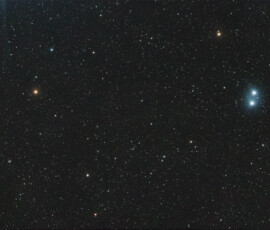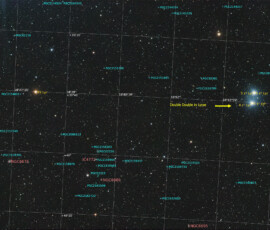Epsilon Lyrae (ε Lyr, ε Lyrae), also known as the Double Double, is a multiple star system of at least five stars approximately 160 light-years away in the constellation of Lyra.
The component stars of ε1 have magnitudes of 4.7 and 6.2 separated by 2.6″ and have an orbital period that can only be crudely estimated at 1200 years, which places them at roughly 140 AU apart. Main components of ε2 have magnitudes 5.1 and 5.5 separated by 2.3″, and orbit in perhaps half that period. ε1 and ε2 are more than 0.16 light years apart. An observer at one pair would see the other as strongly as a quarter-illuminated Moon, less than a degree away from each other. The fifth component of this system, orbiting one of the ε2 pair, was detected by speckle interferometry in 1985

